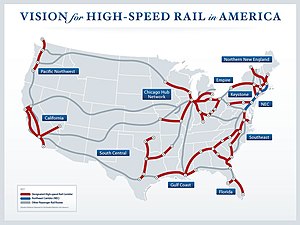 Image via Wikipedia
Image via WikipediaOver the last two years since the election of President Obama, the big rage has been high speed rail. The administration has been very supportive of rail and has been pushing special funding for projects including ones in Florida and California. Even Utah Transit Authority joined a coalition that supports high speed rail in several western states.
However, after the recent elections several states that were on the fast track for rail improvements now have governors that are putting the breaks on those systems including Wisconsin and Ohio. In addition the ARC tunnel from New Jersey into Manhattan has been canceled by the new governor of New Jersey.
The question we have to ask is if these high speed rail projects are the best way to spend our money.
I am going to say that some of these projects just do not make that much sense. A perfect example is the project between Tampa and Orlando. As was mentioned in a previous issue of This Week In Amtrak, this route is only 81 miles. While the current Amtrak service is not that fast, you also have to take into consideration that the some of the current Amtrak route has severe speed restrictions.
It would cost substantially less to upgrade the existing rail line and provide additional trains in the market. Not only would the construction cost be substantially less but the cost to operate the system would be substantially less.
What many people do not take into consideration is the cost of maintaining the high speed network. While cost increases the higher the speed, the cost goes up exponentially once you reach the 110mph mark.
Wisconsin is another example of spending money for the sake of so called high speed rail. The proposal was to spend $800 millions dollars to build a line that would run at a maximum speed of 110mph. While some upgrade of tracks are needed especially near Madison where most of the tracks are relatively slow speed freight racks.
However, the question needs to be asked, would you see that much more ridership with the train operating at 79mph than you will at 110mph? For the relatively short distance of the route would the increase speed have enough increase in ridership to justify the increased cost of the speed increase?
Let me make it clear, I believe that rail service is and will be successful. California and Washington are two examples showing that rail passenger service can be a success. What I question is spending huge sums of money in areas that probably do not call for that kind of investment.
Look at the investment that California is looking to make in high speed rail. Could the money be more effectively used by upgrading the existing rail networks, getting rid of slow spots, fixing bottlenecks, removing dangerous grade crossings than investing in all new infrastructure?
However, I do see one spot where investment is needed in a new rail line and that is between the Los Angeles area and Bakersfield. Currently there is no viable rail route between the two cities. A new route would could not only benefit rail passenger service but could also benefit Union Pacific and BNSF by giving them an alternative to the only rail route south of Bakersfield through the Tehachapi area
I support an effective rail passenger system in the United States which we do not have right now. However, we need to walk before we can run and when it comes to rail passenger service we are not even crawling in the United States yet.

1 comment:
thank fo posting for any help click here
Designing Buildings
Post a Comment